Cruise missile P-35
After the completion of preliminary work on the P-5 project, it was decided to create two new cruise missiles for the naval fleet. On August 17, 1956, the USSR Council of Ministers issued a decree according to which OKB-52 was to develop the P-6 and P-35 missiles. The first was intended to equip submarines and partially replace the P-5 being developed, and the second was to become an armament of surface ships. The P-5 project was to be used as the basis for two new missiles. It was also required to ensure maximum unification of two new products.
The N-5 cruise missile developed at that time had several important features that distinguished it from previous weapons of a similar purpose, but it was not without flaws. The main one was the use of autopilot without any homing systems. Because of this, such a rocket could only be fired at area targets with a sufficiently large QUO. In the case of two new projects, the technical assignment immediately stipulated the use of control and guidance systems. This required the use of a new combined system. On the most part of the flight trajectory, the missiles were to be controlled by the radio command system, and aiming at the target in the final segment was the task of a promising homing head.
The requirement to unify new missiles with the product under development to some extent simplified their design. For this reason, the P-35 rocket turned out to be very similar in appearance to the base P-5, as well as to the P-6, intended for submarines. However, for various reasons, several innovations of one kind or another had to be provided for in its design. The most noticeable differences of the P-35 from other missiles of the family were the presence of a conical central body in the air intake, as well as the fairing of the starting engine. P-5 and P-6, in turn, had a simple unregulated air intake, and their starting accelerators had the form of two cylinders with nozzles connected to each other and without additional aerodynamic elements.
Other features of the exterior of the P-35 rocket were similar to other products of the family. There was a cylindrical fuselage with a lively shaped head fairing. Under the central part of the bottom there was an air intake of the main engine, which sharply changed the cross-section of the fuselage. To the tail, the fuselage again decreased and received a circular cross section, ending with a main engine nozzle. The total length of the rocket slightly exceeded 10 m. The diameter of the fuselage was equal to 1 m.
The main aerodynamic surface of the P-35 rocket was a collapsible swept wing with a span of 2,6 m. In order to reduce the transverse dimensions of the product in the transport position, an automatic wing layout was developed as part of the P-5 project. A small section of the center section was rigidly attached to the fuselage, and the main part of the planes was a folding console. In the transport position, the consoles should be positioned vertically and secured with special locks. After the launch of the rocket from the launch container, the automatics had to lift the consoles on their own and secure them in that position, ensuring the correct flight. With the wing folded, the cross-section of the rocket did not exceed 1,55 m.
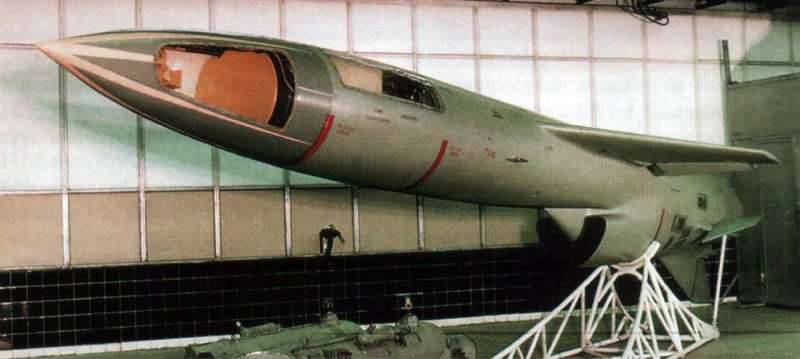
Model of the P-35 rocket with openings for demonstration of internal units. In particular, the radar antenna seeker is visible. Photo Bastion-karpenko.narod.ru
To control the rocket received a set of planes and rudders in the tail section. There were small one-turn stabilizers, elevators and a keel with a rudder. To reduce the dimensions of the rocket, the keel was located under the fuselage, and next to it were the attachments for the reset starter engine.
The power plant of the P-35 rocket was similar to the previous products of the family. For the start, it was proposed to use a dual solid-fuel accelerator with more than 36 tons with a supply of fuel for 2 from work. The flight was proposed to be performed using a turbojet cruise engine KRD-26 with a 2250 kg bollard. The turbojet engine was supposed to provide average flight speed at the level of 1250 km / h. At the same time, the exact parameters of the power plant operation depended on a number of factors, both on the flight program and on the ambient air temperature. According to reports, under certain circumstances acceleration to 1600 km / h was possible.
The P-35 rocket had a launch mass of about 5300 kg. Of these, 2330 kg accounted for the dry mass of the rocket and about 800 kg per detachable starting engine. In the central part of the fuselage, a compartment was provided for mounting a warhead weighing up to 1000 kg. To hit the target, it was proposed to use a high-explosive charge or a special warhead with a power, according to various sources, 20 CT.
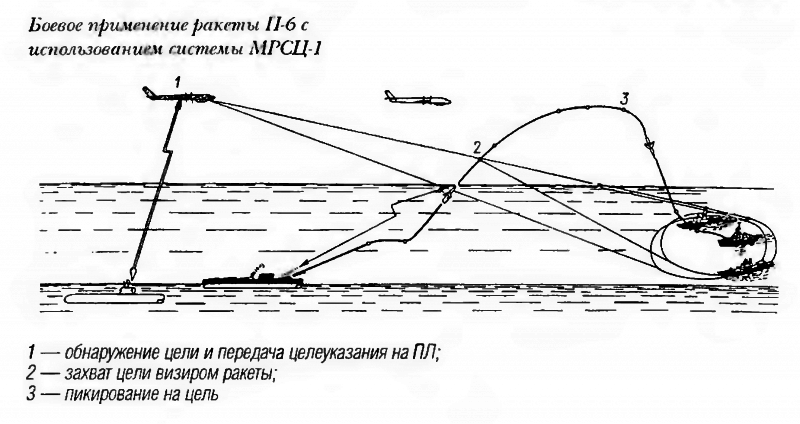
The use of missiles P-6 with third-party target designation and signal retransmission. The general principles of such work are similar to the "M" mode of the P-35 rocket. Figure Shirokorad AB Weapons of the domestic fleet. 1945-2000.
The control systems for the new cruise missile were developed simultaneously with the equipment for the P-6. At the same time, it was decided to add some new devices to it. Already existing guidance systems with some new units were proposed to be used in the "M" ("sea") mode for attacking surface targets. The new mode "B" ("coastal") was intended to attack stationary objects on the shore. The full complex of the control equipment received the designation APLI-1.
When using the “B” mode, the automatics, having received the coordinates of the target, had to climb to a greater height and automatically follow to the target area. At some distance from the target, the rocket had to go into a dive from a high angle and hit a given object.
The “M” mode was more complicated and involved a greater amount of hardware. Immediately after launch, the rocket was supposed to rise to an altitude of up to 7-7,5 km and to maintain a predetermined course using the autopilot. At the same time, the operator of the missile complex was to monitor the rocket and adjust the direction of its movement. Noticing the deviation of the rocket from a given course, the operator had to drive its rudder. At a distance of the order of 40 km from the target, an active radar homing head was connected to the work. At first, it had to work as a remote radar station: monitor the area, and also transmit the data on the objects found to the operator’s console. Having defined the goal, the operator had to give a command to capture. After that, the GOS began to independently track a given target and point a rocket at it. The last leg of the flight was to take place at altitudes of the order of 100 m. A similar algorithm for the operation of the guidance systems allowed the firing of a volley with the distribution of targets between several missiles.
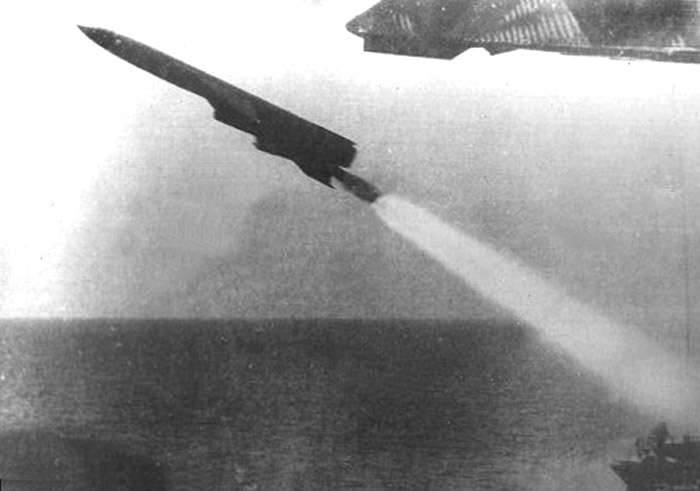
Launch of the missile from the cruiser "Grozny" pr 58. Photo Militaryrussia.ru
To detect targets, the carrier ship was supposed to use the standard radar provided for in its project. It was proposed to control the rocket using the Binom system. Over time, a variant of the control complex, designed to significantly increase the range of missiles. In this case, an airplane or a helicopter with radio signal relay equipment appeared between the carrier ship and the target. Depending on various factors, including the use of repeaters, the range of the P-35 rocket could reach 300 km. The Tu-16РЦ and Tu-95РЦ aircraft, as well as Ka-25РЦ helicopters could be used as auxiliary equipment carriers.
It was proposed to launch new missiles using special launchers with separate containers. By the end of the fifties, specialists of TsKB-34 together with the Bolshevik plant developed launchers of several types. The SME-142 product allowed for the transport and launch of one rocket, while the CM-70 and CM-82 installations contained four missiles each. These systems were designed to solve various problems, but had a partially similar design. The basis of all installations was a cylindrical container with a length of about 12 m with an internal diameter of 1,65 m. It contained rails for moving the rocket, as well as connectors for connecting with ship systems and other equipment. Both end caps of the container could open. The front, opening, provided the exit of the rocket, and the opening of the rear diverted the gases of the starting engines.
Of the three launchers, the CM-82 was the first to be activated. This product with four containers was intended for ground tests of missiles. The first launch of the P-35 rocket in an incomplete configuration took place on October 21 of the year 1959 - several months before the start of similar checks on the P-6 product. Until March of the following year, the testers completed five test launches in which they used missiles without electronic equipment.
In 1959, a test vessel was prepared to continue testing ship cruise missiles. Available in the presence of the cargo ship "Ilet" received a single container launcher SME-142 and a set of control equipment. After this alteration, the cargo ship was renamed OS-15. The trial vessel was to work on the landfills of the Caspian Sea.
27 July 1960, a former dry cargo ship, launched the P-35 rocket for the first time with a full set of equipment. At this stage of the test was spent seven missiles. The test results were considered unsatisfactory. The control equipment of the APLI-1 was still “raw” and did not show the required characteristics, which required further development. Further tests were started only after the completion of work to improve the equipment of the rocket.
All the necessary work was completed only by the end of 1962. Then OS-15 again went to the landfill to perform test firing. The new stage of trial launches was more successful. In addition, during these tests, the P-35 rocket showed its full potential in hitting targets. Several shooting was carried out using targets in the form of decommissioned ships. The results of these launches were of great interest.
In one of the test launches of the P-35 rocket with OS-15, a target was used - an unfinished destroyer of the 48 Kiev project. This ship was laid in 1939 year and was to join the fleet in 42, however, the beginning of the war stopped the construction on readiness less than 50%. In the early fifties, the unfinished “Kiev” became the means for conducting various tests, and testing the capabilities of the P-35 rocket was his last task.
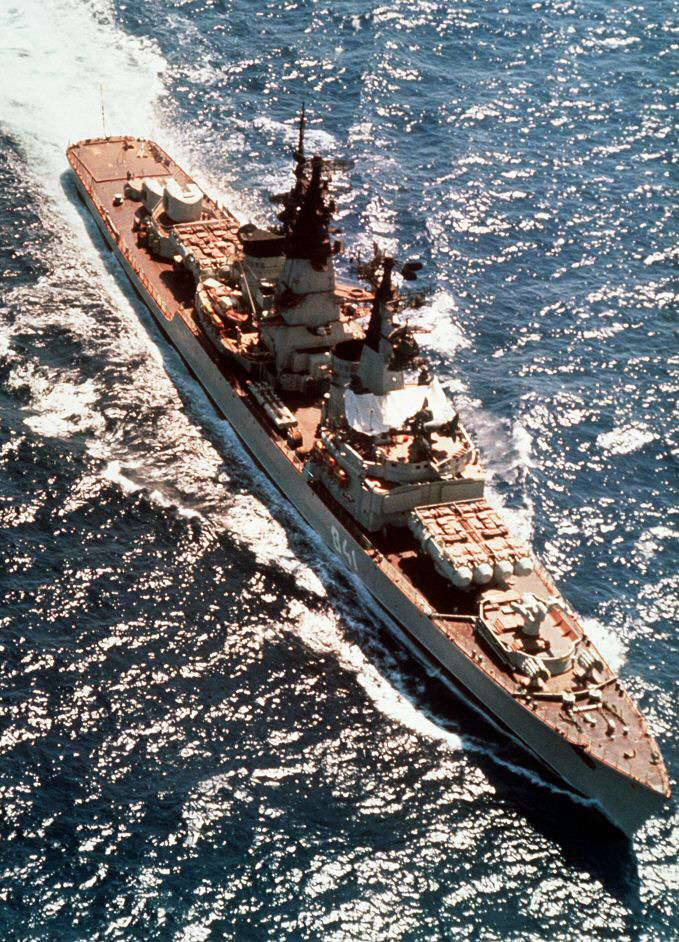
Rocket cruiser "Admiral Golovko" project 58. Before setting is the launcher CM-70. 1990 g. Photo by Wikimedia Commons
In test launches on target ships, P-35 missiles with inert equipment were used (with a warhead weight simulator). The rocket fired at Kiev was successfully aimed at the target from its forward hemisphere and hit exactly into it. The rocket hit the left cheekbone of the hull. After that, the supersonic rocket due to its energy and mass proportional to the target deck at a distance of about 50 m. Because of this interaction with the target, the rocket glider collapsed, but the cruise engine retained relative integrity. The engine broke through all the internal structures of the target hull, which were in its path, and then broke through its bottom. Through the formed hole water began to flow, and after about three minutes the target ship sank.
According to the results of all tests, the P-35 rocket and a set of appropriate equipment for the ships were pleasant to use. Carriers of such weapons were to be ships of several new types. By the time the missiles were put into service, some ships had already been built, others appeared a little later.
The first carriers of the P-35 missiles were to be the new destroyers of the 58 project. At the end of 1956, the shipbuilding industry received a technical assignment to develop such a ship, which took into account the use of new cruise missiles. The technical design of the new ships was prepared at the beginning of 1958, after which preparations began for the construction of future carriers of missile weapons. Interestingly, during the first few years the 58 project managed to change the classification several times. Initially, these ships were considered destroyers, but the proposed weapons did not meet the requirements for such ships. As a result, the designation “ship with reactive armament” appeared. Only in the 1962 year, after the demonstration of ships and missiles P-35 to the leadership of the country, the 58 project was designated as a cruiser.
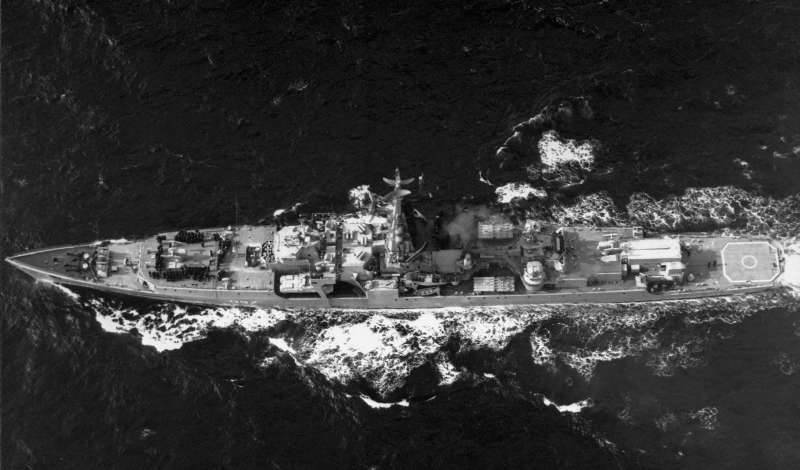
Missile cruiser "Vice-Admiral Drozd" project 1134. Launchers KT-35 located on the sides of the superstructure behind the tank. 1985 g. Photo by Wikimedia Commons
The P-35 missile was to become the main strike weapons of the ships of the new project, designed to attack surface and ground targets. Each 58 cruiser received two CM-70 launchers located in front of and behind the superstructure. The design of installations made it possible to direct missiles horizontally within a sector of width 120 ° and raise by an elevation angle to + 25 °. In order to avoid damage to the superstructure during the attack, the ship had to go at a certain angle to the rocket’s flight path and rotate the launcher to the desired angle, diverting the gases of the starting engines overboard. The ammunition of the 58 cruisers consisted of X-NUMX P-16 missiles. Eight products were stored directly in the launch containers, the rest were located in two cellars near the facilities. According to some reports, the standard ship ammunition was 35 missiles with a high-explosive warhead and 12 with a special one - one for a full volley of the launcher.
It was originally planned to build 16 ships of the 58 project, but later the series was reduced four times. From 1962 to 1965, the navy included the cruisers “Grozny”, “Admiral Fokin”, “Admiral Golovko” and “Varyag”. New ships were distributed among all the main fleets. In the future, some project ships were transferred several times to other fleets. Most of the cruisers of the project 58 continued service until the early nineties, after which it was written off. The most "tenacious" was the ship "Admiral Golovko" from the Black Sea Fleet, which completed service only in 2002 year.
During testing and service cruisers project 58, it was found that existing launchers with their own guidance systems do not have high performance and in fact do not make sense. For this reason, in the mid-sixties, a new KT-35 or KT-35-1134 system was developed. Its structure was attended by two stationary container oblique arrangement. Guidance systems were not envisaged, it was only possible to shoot forward in the course of the carrier ship.
In the second half of the sixties, four 1134 missile cruisers were built: Admiral Zozulya, Vladivostok, Vice Admiral Drozd and Sevastopol. The 1134 project to a certain extent was a development of the 58 project, but it had a lot of differences. In particular, instead of the SM-70 rotary launchers, they received two CT-35 products located along the sides of the front of the superstructure. Reloading launchers did not provide, because of what the ammunition consisted of only four missiles P-35.
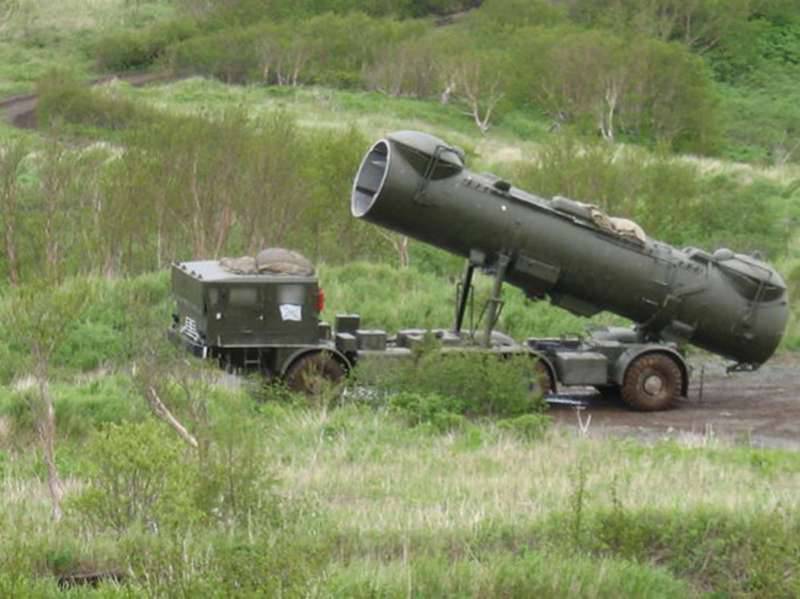
The launcher of the coastal missile complex "Redoubt". Inside the container is a P-35 rocket. Photo Rbase.new-factoria.ru
The 1134 project cruisers served as part of the Northern (three ships) and Pacific (one) fleets. In the late eighties and early nineties, these ships were decommissioned and cut into metal due to moral and physical obsolescence, as well as financial problems of the navy.
The appearance of the P-35 cruise missile made it possible to significantly increase the strike potential of navy ships and increase the range of surface targets. With proper organization of target search, target designation and execution of a missile strike, the attack range of enemy ships reached 300 km. In addition, it was possible to destroy ground targets with previously known coordinates at similar distances.
Nevertheless, the P-35 complex had some drawbacks, the main ones of which, however, were not related to the design of the missiles, but to the number of their carriers. During the sixties, only eight missile cruisers with launchers for the P-35 were built. The 58 project cruisers could carry eight ready-to-use missiles and the same spare ammunition, while no more than four missiles were present on the 1134 project cruisers. Naturally, the full implementation of plans for the construction of 16 cruisers of the 58 project could further increase the fleet's strike potential, but only four such ships were built. Similarly, the situation with the cruisers of the project 1134.
Cruise missile P-35 has become another option for the development of ideas embodied in the original project P-5. However, it did not become the last development of its family. Already in the mid-sixties, several new projects began, the purpose of which was to develop the existing structure and improve its characteristics. Thus, a new Progress missile was proposed for use on ships, and coastal forces were to receive the Utes and Redut missile systems. Thus, the initial project was again developed and led to the next growth of the potential of the USSR Navy.
Based on:
http://rbase.new-factoria.ru/
http://warships.ru/
http://bratishka.ru/
http://flot.sevastopol.info/
http://militaryrussia.ru/blog/topic-392.html
Shirokorad A.B. Weapons of the domestic fleet. 1945-2000. - Minsk: “Harvest”, 2001
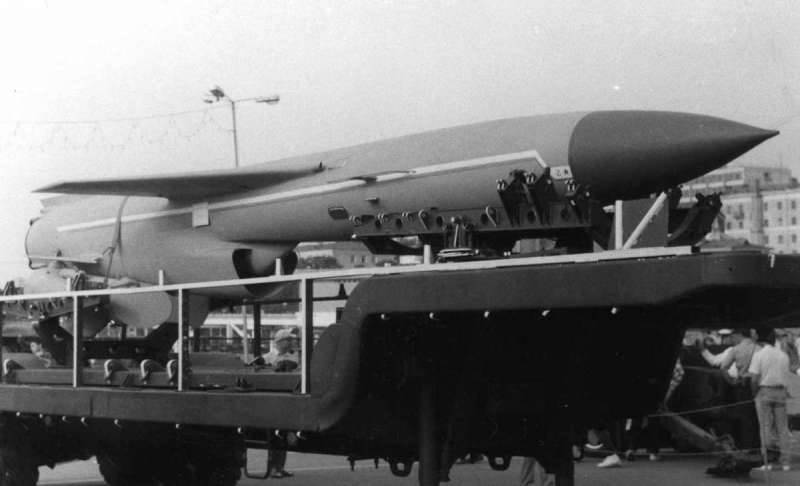
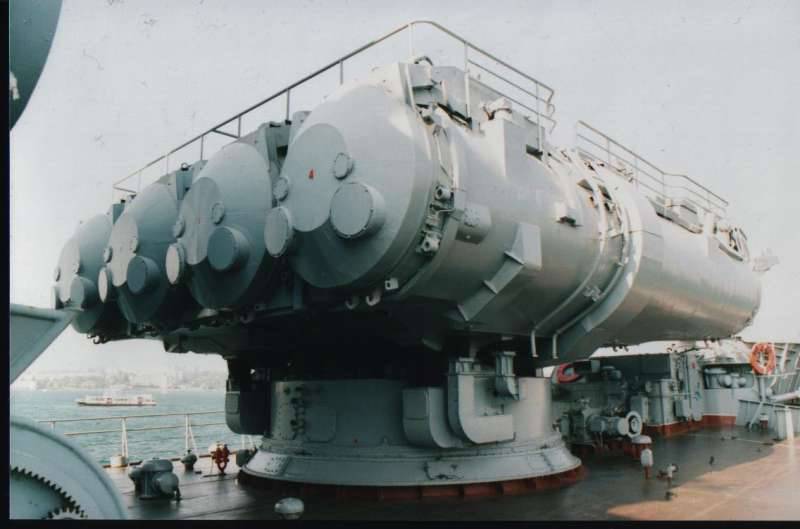
Information